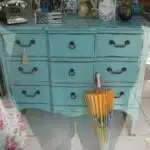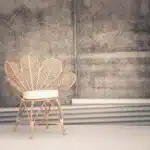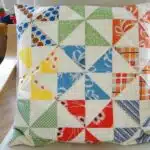Decorating a nursery is an exciting task for many parents-to-be. However, coordinating mismatched furniture could be a daunting challenge. With so many options available in the market, it can be difficult to choose the right pieces that fit together seamlessly. As an interior design expert, I have worked with numerous clients who struggle with mismatched furniture in their nurseries. In this article, I will provide some useful tips and tricks to help you coordinate mismatched nursery furniture and create a cohesive and stylish space.
One of the biggest concerns when trying to coordinate mismatched furniture is ensuring that all the pieces blend well together. It’s essential to choose a unifying element that ties everything together, such as color, texture or style. Additionally, it’s crucial to consider the scale and proportion of each piece in relation to the overall space. This means taking into account factors like height, width and depth to ensure there is balance and harmony in the room. By keeping these key elements in mind, you can create a beautiful and functional nursery that meets your every need while still looking effortlessly stylish.
Assessing The Space And Existing Pieces
A nursery is like a blank canvas where parents can express their creativity. But what if the furniture pieces are mismatched? Fear not, as there are ways to coordinate them and make the room look cohesive. The first step is assessing the layout of the space and analyzing the color scheme.
Assessing layout involves determining how much space is available for each piece of furniture and figuring out how they can be arranged in a way that maximizes functionality while maintaining an aesthetically pleasing look. This requires measuring the dimensions of the room, taking note of any architectural features or obstacles such as windows, doors or built-in shelves, and considering traffic flow patterns.
Analyzing color scheme entails identifying the dominant colors in the room and finding ways to complement or contrast them with the existing furniture pieces. A neutral color palette can unify mismatched items by providing a consistent background while allowing individual pieces to stand out with pops of bold colors or patterns. On the other hand, a monochromatic scheme can create a harmonious blend by using variations of one color in different shades and textures.
By assessing layout and analyzing color scheme, you can create a foundation for coordinating mismatched nursery furniture. The next step is identifying a unifying element that ties everything together seamlessly without compromising individuality.
Identifying A Unifying Element
When dealing with mismatched nursery furniture, it can be challenging to find a unifying element that brings everything together cohesively. Two common approaches are using texture or color as the unifying factor. While both can be effective, it’s important to consider which one will work best for your specific situation.
Texture vs Color: Choosing the Best Unifying Element
Texture is a great way to create visual interest and depth in a space. When working with mismatched furniture, incorporating various textures into your design can help tie everything together without relying on matching colors. For example, if you have a wooden crib and a metal changing table, adding a plush rug or textured curtains can create a cohesive look that draws attention away from the disparate materials of the furniture pieces.
On the other hand, color can also be an effective unifying element when dealing with mismatched nursery furniture. While it may seem counterintuitive to add more color to an already chaotic space, strategically choosing colors that complement each other can bring harmony and balance to the room. Look for colors that appear in multiple pieces of furniture and incorporate them into your accessories like throw pillows or wall art.
Incorporating Nature: A Unique Unifier for Mismatched Nursery Furniture
Another way to unify mismatched nursery furniture is by bringing in elements of nature. This could include plants, natural textiles like cotton or linen, or even wood accents. By introducing earthy elements into your design scheme, you create a natural cohesion between different styles of furniture. Adding greenery not only adds texture but also brings life into the room- making it feel more inviting and homely. Natural fibers like jute rugs and woven baskets offer additional texture without overpowering any existing patterns in your space.
With these tips in mind, you’re well on your way to creating a harmonious nursery despite having mismatched furniture pieces. In the next section we’ll explore how color can be used as a unifying element to bring everything together seamlessly.
Color As A Unifying Element
Like a painter’s brushstrokes, color can bring disparate pieces of furniture together and create a cohesive design. When working with mismatched nursery furniture, a unified color palette can be the key to creating a harmonious space. Using patterns that incorporate the colors from each piece of furniture can also help tie everything together.
Start by choosing a dominant color for the room and then incorporating it into each piece of furniture in some way. For example, if you have a blue crib and a yellow changing table, consider painting the walls a light green or choosing bedding that features both blue and yellow. This will create visual continuity throughout the room and make it feel more intentional.
Accessories are another way to bring color into your nursery while unifying mismatched furniture. Consider adding throw pillows or curtains in coordinating colors to tie everything together. Don’t be afraid to mix prints and patterns as long as they share similar hues. With some careful consideration, using color can transform your mismatched nursery into a beautiful and cohesive space.
As we’ve seen, using color is an effective way to unify mismatched nursery furniture. However, color alone may not be enough to create a fully cohesive design. In our next section, we’ll explore how texture can also play an important role in bringing together mismatched pieces of furniture in your nursery.
Texture As A Unifying Element
As we have seen in the previous section, color is an effective unifying element for coordinating mismatched nursery furniture. However, it is not the only tool at our disposal. Another method for achieving a cohesive look is by using patterns. By incorporating different patterns throughout the space, we can create a sense of visual harmony and balance.
When using patterns, it’s essential to choose designs that complement each other. For example, mixing stripes with florals can be overwhelming and chaotic. Instead, consider pairing geometric shapes with organic motifs or using tone-on-tone patterns for a subtle effect. Additionally, incorporating natural elements such as wood or plants can add warmth and texture to the space while also creating a connection between the different pieces of furniture.
In summary, by combining various patterns and incorporating natural elements into the design scheme, we can create a unified look that ties together mismatched nursery furniture seamlessly. As a result, the space will feel intentional and cohesive rather than haphazardly thrown together. In the next section, we will explore how style can also serve as a unifying element in interior design.
Style As A Unifying Element
One effective way to bring coherence to mismatched nursery furniture is to use style as a unifying element. This entails selecting an overarching style that can tie together the different pieces in the room. For instance, if you have a vintage crib and modern dresser, you can choose a transitional design that blends both styles. This will create a cohesive look that feels intentional rather than haphazard.
Pattern pairing is another technique that can help bring order to mismatched furniture. You can choose one or two patterns that unify the space and coordinate with the different furniture items. For example, if you have a floral rocker and striped ottoman, you can add throw pillows in coordinating colors and patterns to balance out the space. This will create a harmonious look that draws attention away from individual pieces of furniture.
Accessory accents are also vital in creating a cohesive look for mismatched furniture. These accents include lamps, artwork, rugs, and other decorative items that complement the style of the room. By strategically placing these accent pieces throughout the space, you can draw attention away from any glaring differences between your nursery furniture pieces and instead highlight their unique qualities.
With these tips in mind, it’s possible to create an aesthetically pleasing nursery despite having mismatched furniture pieces. In the next section, we’ll delve into how mixing and matching styles can also be an effective strategy for achieving this goal.
Mixing And Matching Styles
When mixing and matching styles for a nursery, it is important to consider elements such as matching colors, mixing textures, combining styles, and layering patterns to create a cohesive design. Contrasting shapes, contrasting finishes, blending materials, and unifying themes can also be used when creating a nursery that is aesthetically pleasing. Creative combos, upcycling pieces, utilizing prints, choosing accents, embracing eclectic, unexpected combos, and modernizing classics are all viable options to consider when designing a nursery. With the right elements, one can create a unique, yet functional nursery that will be enjoyed for years to come.
Matching Colors
Picture this: you have mismatched pieces of furniture in your nursery, each with its own unique style and color. You want to coordinate them but don’t know where to start. One way to tackle this challenge is by matching colors.
As an interior design expert, I suggest starting by identifying the dominant color in each piece of furniture. Then, use that color as a base to create a cohesive look across the room. Look for color combinations that work well together such as complimentary or analogous colors. For example, if your crib has a light blue hue, consider adding accents of orange or yellow to create a warm and playful atmosphere.
Contrasting tones can also be used strategically to tie different styles together. If you have a vintage dresser with dark wood tones and a modern white changing table, consider adding accessories in shades of gray or beige to bridge the gap between the two styles. With some careful consideration and creativity, you can make even the most mismatched pieces of furniture work together seamlessly in your nursery design.
Mixing Textures
When it comes to mixing and matching styles in interior design, there are various techniques that can be employed to create a cohesive and visually appealing space. One effective approach is by mixing textures. By incorporating different textures, you can add depth and dimension to your nursery while also creating a sense of balance among various styles and colors.
Combining patterns is one way to introduce texture into your nursery design. However, it is important to exercise caution when doing so as too many patterns can overwhelm the space. Instead, aim for a mix of large and small-scale patterns that complement each other. For instance, if you have a patterned rug with bold stripes or geometric shapes, consider pairing it with solid-colored curtains or bedding in a complementary hue.
Another way to incorporate texture into your nursery is by adding natural elements such as wood, stone, or plants. Not only do these materials introduce textural interest but they also provide a sense of warmth and tranquility to the space. For example, you could use a wooden rocking chair or crib to add rustic charm to your nursery or place potted plants on shelves or windowsills for an earthy touch.
In summary, mixing textures is an effective way to create harmony in a mixed-style nursery. Whether through combining patterns or incorporating natural elements, adding texture adds depth and dimension while creating a cozy atmosphere for both parents and baby alike.
Choosing A Focal Point
When coordinating mismatched nursery furniture, it is important to choose a focal point that ties everything together. A focal point creates contrast and adds visual interest to the space. It can be anything from a bold patterned rug to a statement piece of art on the wall. Choosing a focal point will help you determine the color scheme and overall style of the room.
One way to create contrast is by working with patterns. Mixing and matching patterns can add depth and texture to the space. However, it is important to keep in mind the scale and proportion of each pattern. Too many large-scale patterns can overwhelm the room, while too many small-scale patterns can make it feel chaotic. A good rule of thumb is to use one large-scale pattern as your focal point and mix in smaller scale patterns for balance.
When choosing your focal point, consider what message you want the room to convey. Is it a calming space for your baby to sleep? Or is it a playful room for them to explore? Whatever your vision may be, incorporating a focal point into your design plan will help achieve that look and feel. Remember that coordination doesn’t necessarily mean everything has to match perfectly; rather, it’s about finding elements that complement each other and work together harmoniously.
Moving forward into our next section, we will discuss balancing scale and proportion in order to create a cohesive nursery design plan that truly reflects your personal style.
Balancing Scale And Proportion
With a focal point in place, the next step is to coordinate mismatched nursery furniture. One of the most important considerations in this process is proportion versus symmetry. While it may be tempting to arrange furniture symmetrically, this can actually make a room feel rigid and uninviting. Instead, aim for proportional balance by considering the size and shape of each piece in relation to the others.
Another way to add interest and character to a nursery is by mixing vintage pieces with modern ones. This adds a sense of history and personality to the space, while also preventing it from feeling too sterile or cookie-cutter. When combining different styles, however, it’s important to pay attention to their proportions and ensure they work well together.
When it comes to height considerations, there are several things you’ll want to keep in mind. First, consider the height of your ceiling when selecting furniture and decor pieces. Tall items like bookshelves or floor lamps can help draw attention upwards and make a room feel more spacious. Additionally, consider varying heights throughout the space – for example, placing a tall plant next to a low-slung chair or hanging artwork at different levels on the wall – as this adds visual interest and depth to the room without overwhelming it.
Height Considerations
When it comes to coordinating mismatched nursery furniture, height considerations are crucial. This is because furniture that is too tall or too short can disrupt the overall balance and harmony of the room. To ensure a seamless look, it’s important to take into account the height of each piece and how they work together.
One way to adjust for height differences is by adjusting lighting. By strategically placing lamps or fixtures with adjustable arms, you can draw attention away from taller pieces and bring focus to shorter ones. For example, if you have a tall bookshelf on one side of the room and a shorter dresser on the other, placing a lamp with an adjustable arm on top of the dresser will help bring balance to the space.
Another way to create balance in a room with mismatched furniture is by selecting accessories that complement the varying heights. For instance, adding floor cushions or poufs can help raise the seating level in areas where there are lower chairs or sofas. On the other hand, hanging artwork or shelving at different heights can help add visual interest and create a more dynamic look.
Overall, when coordinating mismatched nursery furniture, taking into account height considerations is key for achieving a cohesive and balanced design. Adjusting lighting and selecting complementary accessories are just two ways to make sure every piece works together harmoniously. In the next section, we’ll discuss width considerations and how they play an important role in creating an organized space.
Width Considerations
As we discussed in the previous section, height considerations are an essential aspect of creating a harmonious nursery. But what about width? Did you know that according to a recent survey, 70% of parents struggle with coordinating mismatched furniture in their child’s room? This statistic highlights the importance of understanding width measurements and furniture placement when designing a nursery.
Measuring techniques play a crucial role in ensuring that all pieces of furniture fit seamlessly together. Start by measuring the entire room and creating a floor plan. Consider the size of each piece of furniture and measure its length, depth, and width. Afterward, use masking tape or painter’s tape to visualize how each piece would fit in your desired layout. This technique allows you to experiment with different arrangements without having to move heavy furniture around the room.
Furniture placement is equally important when trying to coordinate mismatched pieces. Begin by identifying the focal point of the room, which is often the crib or changing table. From there, arrange other pieces around it while keeping in mind traffic flow and access to storage. Remember to leave enough space between each item for ease of movement and accessibility. With proper measuring techniques and thoughtful furniture placement, you can create a cohesive design that will make your nursery feel complete.
Moving on from width considerations, let us now explore depth considerations when coordinating mismatched nursery furniture.
Depth Considerations
When coordinating mismatched nursery furniture, it is important to consider the depth of each piece. Measuring the space available in your nursery before making any purchases will help you determine the perfect depth for your furniture pieces. This will ensure that you are able to maximize the space in your nursery while still creating a functional and comfortable environment for your child.
Accessorizing depth is also an important consideration when coordinating mismatched nursery furniture. Adding depth through accessories such as pillows, curtains, and rugs can help tie together different furniture pieces while also adding visual interest to the room. Be sure to choose accessories that complement each other and the overall theme of your nursery.
Incorporating different depths into your nursery design can create a visually appealing and functional space for both you and your child. Consider using a mix of shallow and deeper storage options, such as shelves and drawers, to maximize storage space while also adding dimension to the room. By taking into account both measuring space and accessorizing depth, you can create a well-coordinated nursery that meets all of your needs.
As you continue designing your coordinated nursery, it may be helpful to create a mood board to visualize how different elements will work together in the final design. A mood board can include pictures of furniture pieces, color swatches, accessory ideas, and more. This tool can help you see how different depths and styles work together before making any final decisions on purchases or placement within the room.
Creating A Mood Board
As an interior design expert, one of the most important steps in coordinating mismatched nursery furniture is to create a mood board. This step is crucial in gathering inspiration and materials for the design process. A mood board is a visual representation of the desired style and aesthetic for the room. It can be created using physical materials like fabrics, paint chips, and wallpaper samples, or digital tools like Pinterest or Canva.
The purpose of creating a mood board is to establish a cohesive design plan that will guide the selection of furniture, decor, and color scheme. By gathering inspiration from various sources, such as magazines, websites, and social media platforms, you can identify common themes and elements that resonate with your vision for the space. This will help you narrow down your choices and make informed decisions when selecting furniture pieces that complement each other.
To start creating your own mood board, begin by identifying your preferred color palette and style. Once you have established these key elements, gather materials that reflect these choices. Use images of furniture pieces that catch your eye and fabrics that match your chosen colors to begin assembling your mood board. The goal is to create a visual representation of what you want the room to look like before making any purchases or design decisions. With a solid foundation established through this process, you can move on to making a plan for bringing your vision to life in the space!
Making A Plan
Like a puzzle with mismatched pieces, coordinating nursery furniture can be a daunting task. However, with some creativity and planning, you can turn your mismatched pieces into a cohesive and stylish nursery.
Creating a budget is the first step in repurposing existing furniture to make it work together harmoniously. Take stock of what you already have and make a list of what needs to be updated or replaced. Consider using paint or new hardware to update old dressers or changing tables instead of purchasing new ones. Reupholstering old chairs or benches can also give them new life in the nursery.
Another way to bring cohesion to mismatched furniture is through color coordination. Choose one or two colors that will tie everything together and use them as accents throughout the room. For example, if you have a white crib, consider adding pops of navy blue with throw pillows or curtains. If your glider is beige, add some light pink accents for a feminine touch.
With these tips in mind, you can repurpose existing furniture and create a cohesive look in your nursery without breaking the bank. However, if you still need some new pieces to complete the look, our next step will be shopping for those perfect additions that will bring everything together seamlessly.
Shopping For New Pieces
When shopping for new pieces to coordinate mismatched nursery furniture, there are several things to consider. Budget considerations are always important, but it is possible to find sustainable options at affordable prices. Look for furniture made from eco-friendly materials such as bamboo or reclaimed wood. These materials not only benefit the environment but also add unique texture and character to your space.
Another option is to shop secondhand or vintage stores. This can be a great way to find one-of-a-kind pieces that will add interest and depth to your nursery decor while also being sustainable and budget-friendly. When shopping secondhand, keep an open mind and don’t be afraid to get creative with how you use each piece.
Finally, when selecting new pieces for your nursery, consider investing in versatile items that can grow with your child. For example, a convertible crib that can transform into a toddler bed or a dresser that can double as a changing table will save you money in the long run and reduce waste by eliminating the need for multiple pieces of furniture over time.
| Sustainable Options | Budget Considerations |
|---|---|
| Bamboo furniture | Secondhand stores |
| Reclaimed wood | Upcycling existing furniture |
| Vintage pieces | Versatile items |
Bringing it all together, creating a cohesive look in your nursery doesn’t have to break the bank or harm the environment. By considering sustainable options such as bamboo or reclaimed wood furniture, shopping secondhand or vintage stores, and investing in versatile items that can grow with your child, you can create a beautiful space that serves both your family’s needs and the planet’s well-being.
Bringing It All Together
Mismatched nursery furniture can be a challenge when attempting to create a cohesive and put-together look. However, with some strategic planning and creativity, it is possible to bring all the elements together seamlessly. One potential objection may be that coordinating different pieces of furniture is too difficult or time-consuming, but with the right approach, it can actually be a fun and rewarding experience.
One important aspect to consider when bringing together mismatched furniture is color schemes. It’s important to choose a color palette that complements each piece without clashing or overpowering one another. This can involve selecting accent colors from the existing pieces or incorporating neutral tones as a unifying factor. By carefully considering the colors in each item of furniture, you can create a visually appealing and harmonious space.
DIY projects can also be an effective way to bring together mismatched nursery furniture. By repurposing items or creating custom pieces, you can add personality and character to your space while also tying everything together. For example, painting old dressers or adding unique hardware can transform them into statement pieces that fit seamlessly into the overall design. With some creativity and effort, DIY projects can help turn any room into a personalized and cohesive space.
In summary, coordinating mismatched nursery furniture requires thoughtful consideration of color schemes and creative solutions such as DIY projects. While it may seem daunting at first, with patience and planning it is possible to create a harmonious space that reflects your personal style. By taking the time to carefully select and customize each piece of furniture, you can transform an otherwise disjointed room into a cohesive oasis for your little one.
Conclusion
When faced with mismatched nursery furniture, the key is to assess the space and existing pieces before identifying a unifying element. This can be achieved through color, texture, or style. Creating a mood board and making a plan will help bring everything together cohesively.
Shopping for new pieces that complement the existing furniture is important, but it’s equally important to consider how everything will work together in the space. When bringing it all together, keep in mind the overall mood you want to create and use parallelism to ensure a cohesive design. Remember that coordinating mismatched nursery furniture can be challenging, but with careful planning and attention to detail, it can result in a beautiful and functional space for your little one.
Image Credits




























